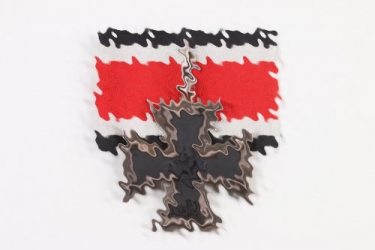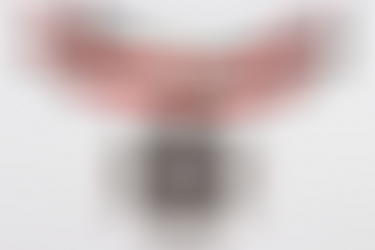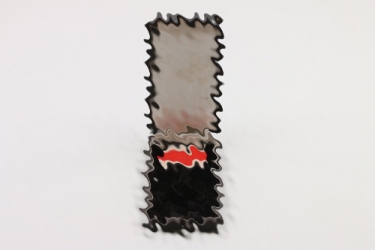2nd USA auction
Bidding on 1036 lots has ended on 22nd October 2022. 74% of all lots sold
Major Arthur Haussels - Award Document to the Knight's Cross of the Iron Cross
GBP 0,00
Own a similar product you want to sell? We are here for you at +49 8541 9053699
-
PAYMENT
-
HOW CAN I PAY FOR MY ORDER?
AUCTIONSYou will receive an e-mail confirming your successful bids the day after the auction has ended. In your personal my ratisbon's you will be able to inform us about your most convenient payment method for this order or tell us about an alternative shipping address.
If we don’t hear from you within 24 hours, we will send an invoice choosing the payment and shipping options which we think are the most comfortable ones to you. If you decide to change your shipping or payment method after receiving your invoice, just drop us a line or visit my ratisbon's/ORDERS for any more details.
SHOP ORDERSChoose your payment method when ordering and submit your order. Once your order has been received we will send an invoice including your shipping costs and your payment instructions.
After receiving the invoice, the order must be paid within 7 days.
Please contact us to discuss layaway options.To learn more about paying at ratisbon's, please see your FAQ pages.
WE ACCEPT FOLLOWING PAYMENT METHODS
-
-
Versand
-
HOW DO YOU SHIP MY NEW TREASURES?
PACKING & TRACKINGWe usually send out orders within 1-3 working days after your payment has been received. In most cases, we are faster than this! We will inform you when your goods are being dispatched and provide a tracking number, In addition, you can always check your order status at my ratisbon's/ORDERS. Delivery times will vary depending upon the delivery destination and type of shipping service you have chosen.
SHIPPING TO ALTERNATIVE ADDRESSIf you prefer to have your order shipped to your work address or a friend during your absence, we will happy to arrange this for you. Send us an email letting us know about your new shipping address and we will be happy to send an updated invoice to you.
OUR LOGISTIC PARTNERS ARE AS FOLLOWS
-
-
OUR GUARANTEE
-
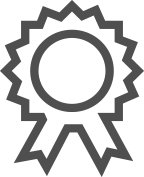 OUR GUARANTEE!
OUR GUARANTEE!We only offer collectables which to the best of our specialists knowledge are authentic. About 15% of all consignments are returned to the consignor after extensive research due to authenticity issues.
Unlike traditional auction houses we do offer a full right of return. If you are not satisfied with what you won or bought, you may return it within 14 days. Please inform us and we will instruct you on how to return the goods. For more information, please visit FAQ pages.
Important note: Cancelling bids after an auction may disappoint the consignor, who like you is a collector. This situation is easy to avoid. We encourage you not to bid on any collectable if you are unsure if it fits into your collection. Ask us to cancel your bid 24 hours prior to the end of an auction to avoid this situation.
-
COUNTRY Germany 1918 - 1945
DIMENSIONS 43.8 x 35.5 cm
WEIGHT
 US LOT 62-0004
US LOT 62-0004EAN 3000000016152
 US LOT 62-0004
US LOT 62-0004PERIOD 1918 — 1945
COUNTRY Germany 1918 - 1945
MATERIAL
DIMENSIONS 43.8 x 35.5 cm
MAKER
WEIGHT
COUNTRY Germany 1918 - 1945
 US LOT 62-0004
US LOT 62-0004DIMENSIONS 43.8 x 35.5 cm
EAN 3000000016152
MAKER
WEIGHT
Description
Major Arthur Haussels (February 4, 1895 – February 13, 1943)
Major Arthur Haussels was the battalion commander (II./Gebirgs-Jäger-Regiment 139/3. Mountain Division) Haussels proved himself in the operation "Weserübung" and in the Battle of Narvik. In March 1942 he took over command of the regiment as successor to Alois Windisch. In 1943, Lieutenant Colonel Haussels commanded the 756 Mountain Jaeger Regiment, which was set up in December 1942. On January 18, 1943, the operation "Eilbote" began under the command of the 334th Infantry Division under Major General Friedrich Weber. His mountain troops flew with Jus 52 from Naples to North Africa. His men conquered the Djebel Solbia mountains and later (under Holzinger) the Djebel Mansour in north-east Tunisia. In this battle, the mountain infantry was defeated by soldiers of the Foreign Legion. "You fought like lions" said a captured foreign legionnaire of German origin after the fight. In February 1943, while in the hospital, Haussels was promoted to colonel for bravery in the face of the enemy.
"[...] I myself flew to North Africa on January 18, 1943, with about 10 men, an infantry gun, 2 field kitchens and various equipment. The group of planes consisted of about 50 machines and flew towards Sicily at a height of about 50 m above the sea. As we approached, we saw another group of Ju 52s circling over Palermo, which then joined our formation. After landing at Tunis airfield, we were overwhelmed by the enthusiasm of our Luftwaffe comrades astonished when unloading, but soon we realized from a pile of wrecked planes that we couldn't overlook that we really had to hurry. Since the German transport planes, for some inexplicable reason, left Naples at the same time as the train at 5 or 6 a.m., the enemy fighter pilots were able to score plenty of kills over the Bay of Tunis. We were lucky that day and were not bothered. 2 days later the planes that had just landed were bombed and the airfield looked as if it had been sprinkled with confetti. The 'confetti' was all the mail for the 5th Panzer Army in Tunisia. At the end of January 1943, a whole group was shot down over the Mediterranean Sea and not a single machine arrived in Tunis. Around January 25, 1943, the Geb.Jäg.Rgt. 756 was detached from the divisional formation and formed an independent combat group with Panzer Battalion 501, equipped with new Tiger tanks, which was used in the sector of a badly battered Italian division. The task of the combat group was to set up an HKL in the mountains to the west and thus for the Africa Army under Field Marshal Rommel arriving from Libya in southern Tunisia to keep their back free. Heavy fighting broke out again and again with the retreating French troops, whose artillery shot very well and who were already being strongly supported by British units. There was particularly fierce fighting around the Djebel Mansour, from which the entire plain with the roads between Medjes Lel Bab and Pont du Fahs southwest of Tunis could be seen. Since the weak Italian garrison could not hold the mountain, we had to fight for the summit of Djebel Mansour three times. In the last attack more than half of the company, platoon and squad leaders were wounded or died. The Allies had established by mid-February a reasonably closed front in the western part of Tunisia and the fighting was intensifying. Our Rgt.Kdr. colonel Haussels was seriously wounded and died shortly afterwards in a hospital in Naples." — Gregor Seidenschwarz, With the Mountain Jaeger Regiment 756 in Africa (Tunisia), in: "The Mountain Troops - Journal of the Comrades' Circle of the Mountain Troops"
The regiment was destroyed in Tunisia in May 1943, the bulk of the team that was operational up to then was captured by the US Americans and distributed to various camps in the US
Haussels, who was fighting at the front line, urging his fighters on with the words "Let's go Jaga!", suffered a shot in the leg during the first combat mission in the Tunis bridgehead, as a result of which he (after treatment at the main dressing station and in the hospital in Tunis) was flown out and in the hospital in Italy died after leg amputation. (From metapedia.org)
Knights Cross of the Iron Cross formal award document issued to Major Arthur Haussels on parchment with an integral blank front leaf, Führerhauptquartier, September 3, 1940. The ornately lettered document is executed in India ink and gold with a hand-inked signature of Adolf Hitler at the bottom. The parchment is just the slightest bit wavy, as is very common in such documents, but otherwise fine condition. Award documents for the Knight’s Cross are rare, even though Hitler granted over 7,000 of them. A severe backlog soon developed and, in the end, very few recipients of the award ever received their large formal award documents.
The document is part of a veteran bring-back that we proudly offer here for the very first time. The GI opted to bring 9 single formal documents in one red presentation leather folder (Mappe) which will be auctioned with Ratisbon’s through a couple of auctions.
Condition
1-
Seller
History Trader Inc., 521 Thorn Street #165, Sewickly, PA 15143-0165, USA
NAME
Knights Cross of the Order of the Iron Cross
DATE OF INSTITUTION
1. September 1939 as the third and new grade of the re-instituted Order of the Iron Cross
AWARD CRITERIA
The Knights Cross of the Iron Cross was awarded for exceptional bravery in the face of the enemy and for outstanding merit in troop leadership. The awarding required the previous awarding of the two lower grades. The Knights Cross was solely awarded by the Führer upon the proposal of the soldiers unit and issued by the Heerespersonalamt. The Knights Crosses were stored at the Ordenskanzlei in Berlin, to be sent to the awardee after approval. There were no Knights Crosses stored at any level of the Wehrmacht before the end of April 1945.
MANUFACTURERS
The Knights Cross of the Iron Cross was produced by seven manufacturers, not including variations amongst the individual companies. The Knights Crosses can be found either unmarked (early Juncker and 3/4 Ring), with a silver content mark, with an LDO number (L/12 and L/52), and later on with the company’s Präsidialkanzlei number (2, 20, 65, and 4). Private sales were forbidden after October 1941.
AWARD NUMBERS
Accurate numbers are not known but the closest estimation is around 7,200, and most likely another couple of hundred on stock at the Präsidialkanzlei.
AWARD DOCUMENTS
The awardee received a preliminary document in A5 format and issued in the name of the Führer by the responsible personnel offices of the three branches of the Wehrmacht. The formal document (Große Mappe) was issued later and only until date of late 1942 / early 1943 due to the huge backlog.
WEARING METHOD
The Knights Cross was worn around the neck on a wider red white and black ribbon which came within the black award case of the Knights Cross.












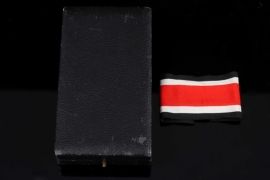

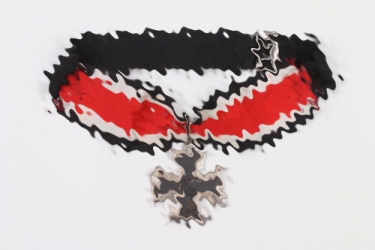
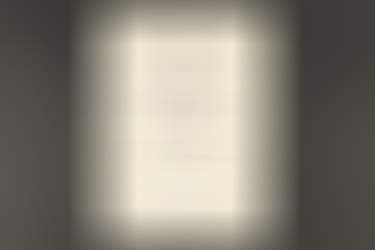



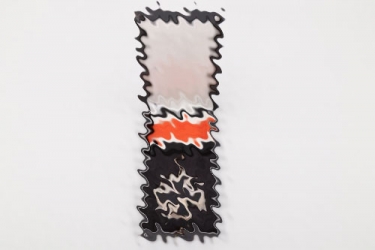

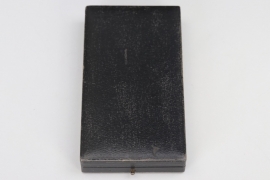

.jpg)
